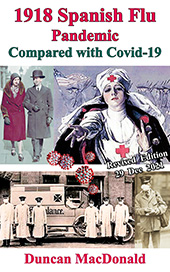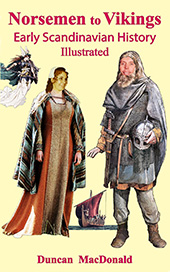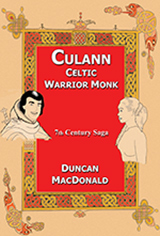Duncan MacDonald
Jakarta 30 April 2010
High cholesterol [ 1 ] is a serious health problem. It's a major risk factor for cardiovascular disease which half 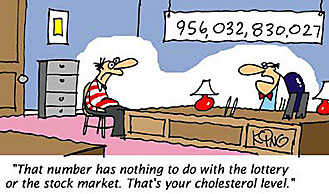 of all men and a third of all women will get at some time in their lives [ 2 ]
of all men and a third of all women will get at some time in their lives [ 2 ] Medical Myth: The healthiest cholesterol level you can have is zero
Medical Fact: If people didn't have any cholesterol, men wouldn't produce testosterone and women wouldn't produce estrogen
Without those, humans wouldn't produce the next generation and the human race would become extinct. So cholesterol itself is not bad. But having too much of the wrong type is bad
What is Cholesterol ?
Cholesterol is a fat, or lipid. [ 3 ] If you held cholesterol in your hand, you would see a waxy substance that resembles the very fine scrapings of a whitish-yellow candle. Cholesterol flows
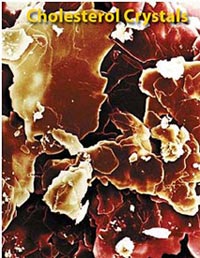 through your body via your bloodstream. But because lipids are oil based and blood is water based, they don't mix. If cholesterol was simply dumped into your bloodstream, it would congeal into unusable globs. To alleviate this problem, the body packages cholesterol and other fats into miniscule protein-covered particles called lipoproteins (lipid + proteins) that do mix with blood. [ 4 ]
through your body via your bloodstream. But because lipids are oil based and blood is water based, they don't mix. If cholesterol was simply dumped into your bloodstream, it would congeal into unusable globs. To alleviate this problem, the body packages cholesterol and other fats into miniscule protein-covered particles called lipoproteins (lipid + proteins) that do mix with blood. [ 4 ] The fat in these particles is made up of cholesterol, triglycerides and a third particle we don't need to discuss here, phospholipid, which helps make the whole particle stick together. Triglycerides are a particular type of fat that have 3 fatty acids attached to an alcohol called glycerol – hence the name. The body needs triglycerides for energy, but as with cholesterol, too much is bad for the arteries and heart
Lipoproteins The two main types of lipoproteins are LDL (low-density lipoprotein) and HDL (high-density lipoprotein). These two particles are as different as night and day
Low-Density Lipoprotein – LDL In most people 60%-70% of cholesterol is carried in LDL particles. LDL act as ferries taking cholesterol to parts of the body that need it at any given time. Unfortunately if you have too much LDL in the bloodstream, it deposits the cholesterol in the arteries which
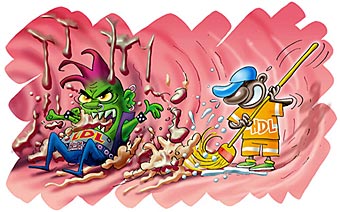 can cause blockages and lead to heart attacks. That is why it is referred to as "bad" cholesterol
can cause blockages and lead to heart attacks. That is why it is referred to as "bad" cholesterol High-Density Lipoprotein – HDL is basically the opposite of LDL. Instead of having lots of fat, HDL has lots of protein. HDL acts as a vacuum cleaner sucking up as much excess cholesterol as it can. It picks up the extra cholesterol from cells and tissue and takes it back to the liver, which either uses it to make bile or recycles it
Your blood cholesterol level is determined by the sum of how much cholesterol your body makes plus how much you take in from food, minus how much your body uses up or excretes. Most evidence suggests our higher cholesterol levels are a product of our high-fat, high-cholesterol diet
Most of the cholesterol carried in your blood is made by your liver. Only a small percentage comes from the food you eat. But certain fats in your diet can cause the liver to make unhealthy amounts of cholesterol – particularly saturated fats and trans fats. In fact these two foo d items do more to raise your cholesterol than the cholesterol in the food you eat
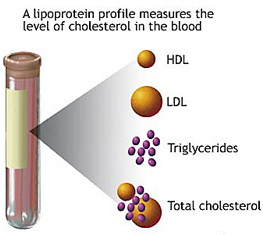
Total Cholesterol Level |
Cholesterol Category |
| <200 mg/dl | Desirable |
| 200 - 239 mg/dl | Borderline high |
| =>240 mg/dl | High |
LDL Cholesterol Level |
|
| <100 mg/dl * | Optimal |
| 100 - 129 mg/dl | Near optimal /above optimal |
| 130 - 159 mg/dl | Borderline high |
| 160 - 189 mg/dl | High |
| => 190 mg/dl | Very high |
Triglyceride Level |
|
| < 150 mg/dl | Normal |
| 150 - 199 mg/dl | Borderline high |
| 200 - 499 mg/dl | High |
| => 500 mg/dl | Very high |
Framingham Heart Study reports suggest that for men, the total cholesterol/HDL ratio of 5 means average risk; 3.4 means about half average risk and 9.6 means double the average risk.
For women the ratios are 4.4 average; 3.3 half average and 7 is twice average.
Conclusion:
The good news is, for most people, if you do heart-healthy things you can lower your LDL (bad) cholesterol and raise your HDL (good) cholesterol.
Lifestyle changes such as eating a diet low in saturated fat and exercising can help reaching your goal
If they are not enough, there are effective medications which help.

